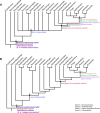Braincase simplification and the origin of lissamphibians
- PMID: 30901341
- PMCID: PMC6430379
- DOI: 10.1371/journal.pone.0213694
Braincase simplification and the origin of lissamphibians
Abstract
Dissorophoidea, a group of temnospondyl tetrapods that first appear in the Late Carboniferous, is made up of two clades ⎼ Olsoniformes and Amphibamiformes (Branchiosauridae and Amphibamidae) ⎼ the latter of which is widely thought to have given rise to living amphibians (i.e., Lissamphibia). The lissamphibian braincase has a highly derived morphology with several secondarily lost elements; however, these losses have never been incorporated into phylogenetic analyses and thus the timing and nature of these evolutionary events remain unknown. Hindering research into this problem has been the lack of phylogenetic analyses of Dissorophoidea that includes both taxonomically dense sampling and specific characters to document changes in the braincase in the lineage leading to Lissamphibia. Here we build on a recent, broadly sampled dissorophoid phylogenetic analysis to visualize key events in the evolution of the lissamphibian braincase. Our ancestral character state reconstructions show a clear, step-wise trend towards reduction of braincase ossification leading to lissamphibians, including reduction of the sphenethmoid, loss of the basioccipital at the Amphibamiformes node, and further loss of both the basisphenoid and the hypoglossal nerve foramina at the Lissamphibia node. Our analysis confirms that the highly derived condition of the lissamphibian braincase is characterized by overall simplification in terms of the number and extent of chondrocranial ossifications.
Conflict of interest statement
The authors have declared that no competing interests exist.
Figures



References
-
- Rage JC, Janvier P. Le problème de la monophylie des amphibiens actuels, a la lumière des nouvelles données sur les affinités des tétrapodes. Geobios. 1982;15: 65–83.
-
- Milner AR. The relationships and origin of living amphibians In: Benton MJ, editor. The phylogeny and classification of the tetrapods 1. Amphibians, reptiles, birds. Oxford: Oxford University Press; 1988. pp. 59–102.
-
- Trueb L, Cloutier R. A phylogenetic investigation of the inter- and intrarelationships of the Lissamphibia (Amphibia: Temnospondyli) In: Schultze HP, Trueb L, editors. Origins of the higher groups of tetrapods: Controversy and consensus. Ithica: Comstock Publishing Associates; 1991. pp. 223–313.
-
- Milner AR. The Paleozoic relatives of lissamphibians. Herpetol Monogr. 1993;7: 8–27.
Publication types
MeSH terms
LinkOut - more resources
Full Text Sources

